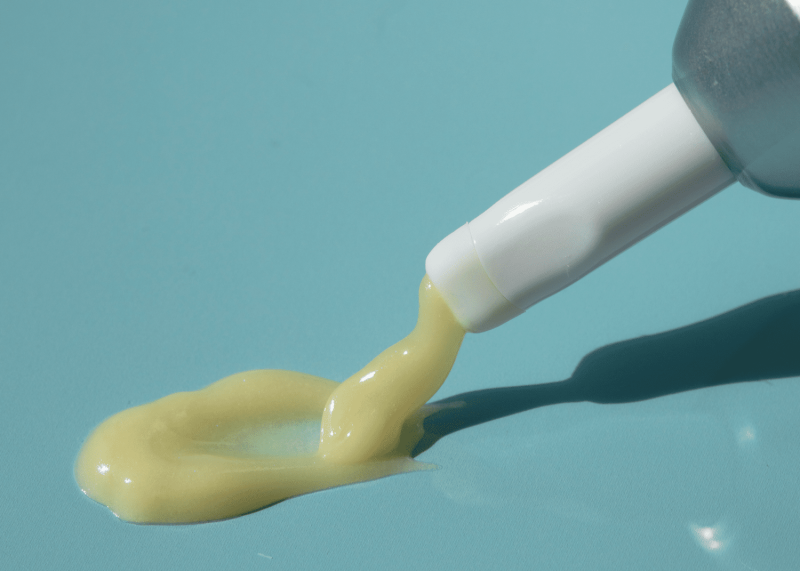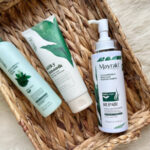
Who Is It For? The Cons The Final Takeaway
While retinol seems to be the answer to nearly all skincare woes—from acne to fine lines—for many, it also may incite some concern. That's because, for every anecdote about the ingredient delivering unblemished skin and a radiant glow, there's another about it yielding flakes, irritation, or worse.
So our interest was immediately piqued when we heard about "retinol sandwiching," a technique said to soften the side effects of retinol while still delivering its benefits. We enlisted the help of two board-certified dermatologists—Marisa Garshick, MD, and Azadeh Shirazi, MD—to explain exactly what a retinol sandwich is, if it works, and how to know if it's right for you. Keep reading to learn more.
What Is Retinol?
Before we break down the retinol sandwich method, it’s important to understand what retinol is and what it does for our skin. “Retinol is a derivative of vitamin A commonly used in skincare products to address the signs of skin aging, smooth lines and wrinkles, lighten discoloration, brighten the complexion, improve skin texture and pores, and treat acne,” says Shirazi. She goes on to explain that retinol boosts circulation and elasticity over time “by encouraging skin cell turnover and renewal… It not only protects [against] collagen breakdown, but it also stimulates collagen and hyaluronic acid production.”
What Is a Retinol Sandwich?
A “retinol sandwich is when you apply a layer of retinol between two moisturizers—like a sandwich—as a buffering method to minimize irritation,” explains Shirazi. To create a retinol sandwich, you apply a layer of moisturizer, followed by a pea-sized amount of your retinol, then a second layer of moisturizer on top, which helps slow the absorption and reduce irritation from the product. This is “particularly beneficial for individuals with sensitive skin or those who struggle with tolerating retinol or retinoid products,” says Garshick.
The Benefits
By minimizing contact with the skin, the retinol sandwich method “effectively reduces the irritation associated with retinol use,” explains Garshick. “This technique also helps skin hydration, controls the absorption of retinol, and allows for customization of retinol concentration and frequency of use.”
How to Try It
“The retinol sandwich method is [a flexible way] to integrate retinol into your evening skincare regimen,” describes Garshick. Incorporating this technique into your routine is simple, however it may feel backward from what you’re used to.
- Cleanse the skin
- Apply moisturizer
- Apply retinol
- Apply a second layer of moisturizer on top
Garshick also recommends reserving "retinol use for evening routines to mitigate sensitivity to sunlight" (since the skin can be more susceptible to burning or redness) and wearing sunscreen during the day to support your overall skin health.
A final tip is to "start by incorporating retinol two to three times weekly, gradually increasing frequency as your skin acclimates," Garshick adds. "Always remain attentive to your skin's response and adjust your regimen accordingly for optimal results."
Who Is It For?
Overall this method is recommended for people with sensitive skin, dry skin, or anyone new to using retinoids. “If you are someone with really sensitive skin and can’t tolerate retinol, then a [retinol sandwich] is a good option,” says Shirazi. Adds Garshick: “For those with sensitive skin, the technique provides a gentler approach.” So if you’ve been hesitant to try retinol because of the strong side effects, it might be worth trying this technique to gain the benefits without compromising your skin.
If you have dry skin, this method addresses those concerns by helping maintain hydration levels via two layers of moisturizer.
The Cons of "Retinol Sandwiching"
When deciding if this technique is worth incorporating into your routine, it's important to note some potential drawbacks. "Despite its gentler approach, some individuals may still experience irritation, redness, or dryness when using the retinol sandwich method. This is especially true for those with highly sensitive skin or those prone to adverse reactions to skincare products," describes Garshick.
Efficacy can also be a concern with the sandwiching method. "The main issue is limiting the potential benefits and the full effect of retinol," says Shirazi. She offers an alternative method for her patients called "retinol staging", which is used "to reduce potential side effects while maximizing the benefits of retinoids." This alternative method involves breaking your routine into two stages: "Cleanse and moisturize early in the evening and wait until hours later, until bedtime, to apply retinol on its own," she explains. The goal ultimately is to allow your skin the time to be prepared to receive the retinol once it is well hydrated. "Unlike retinol sandwiching, this technique doesn't reduce the effectiveness of the retinol because the moisturizer has already been absorbed and your skin moisture barrier is optimized," she tells us.
The Final Takeaway
The retinol sandwich method involves applying a layer of moisturizer before and after a retinol product. It could be worth trying if you have sensitive or dry skin, or experience adverse reactions to skincare products. Just know that it can reduce both the side effects and the benefits of retinol.

